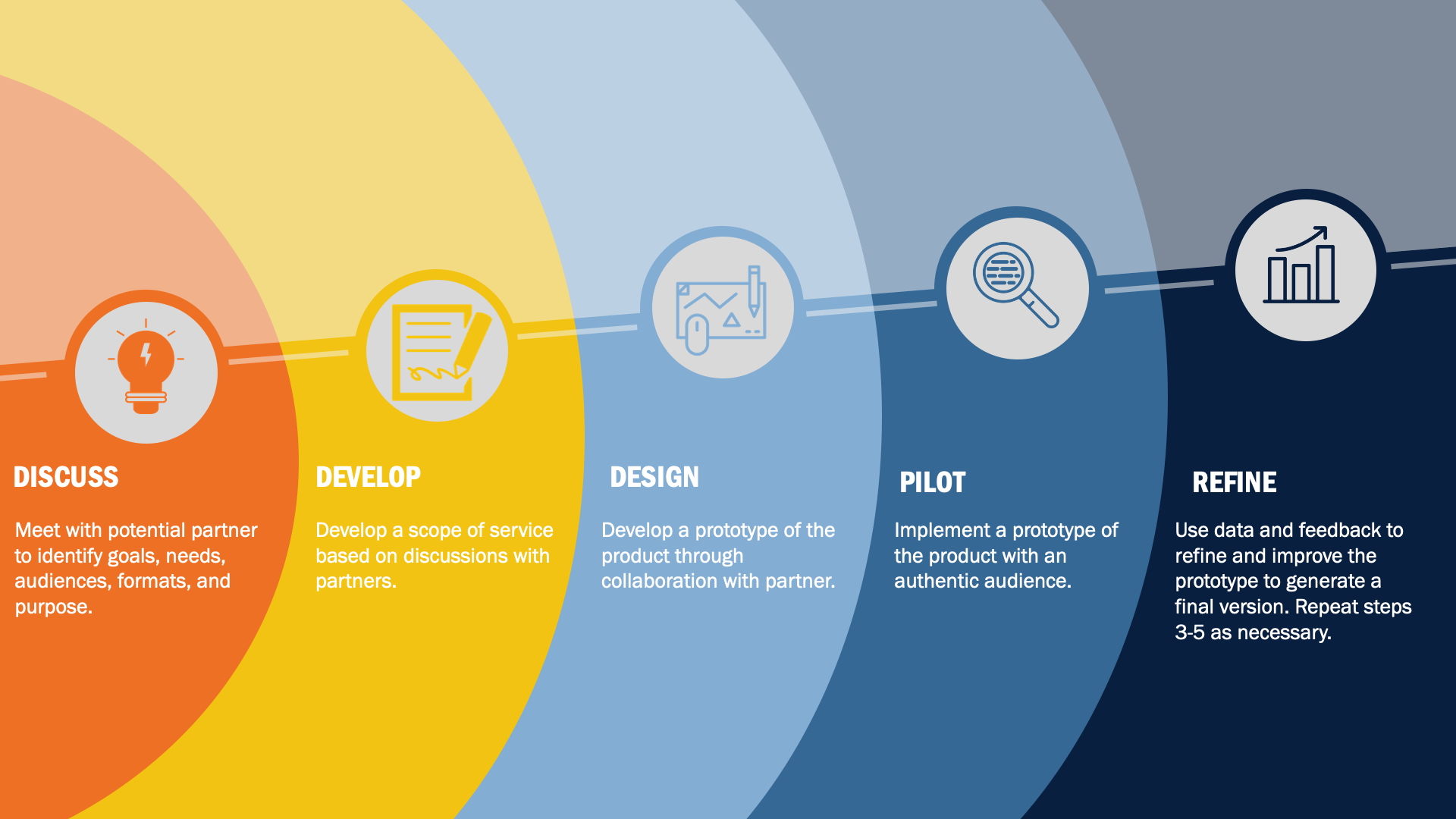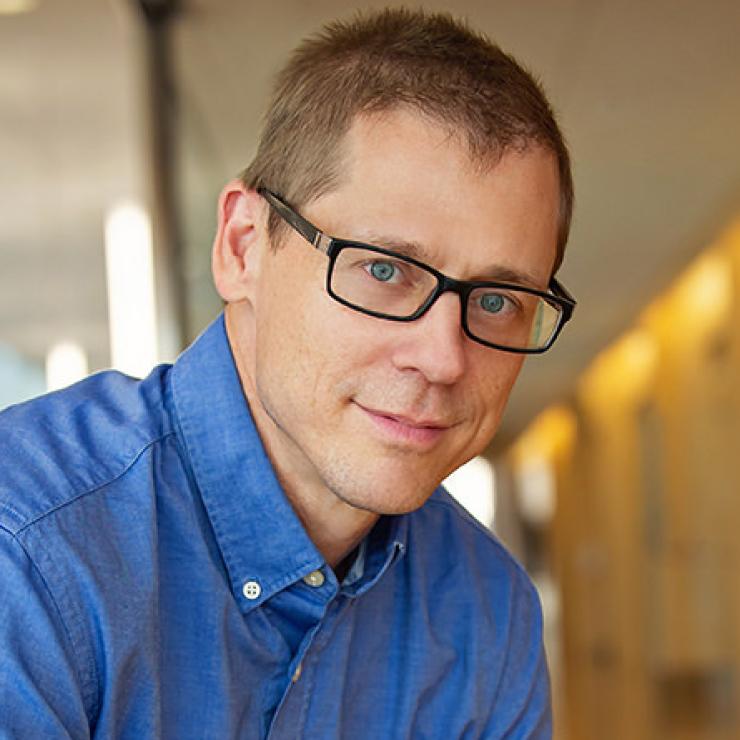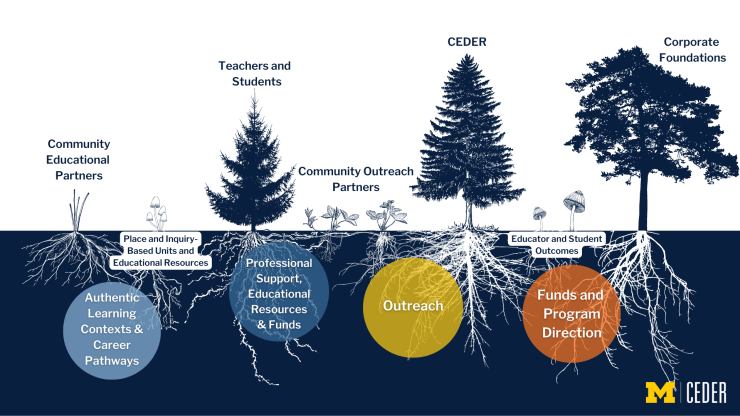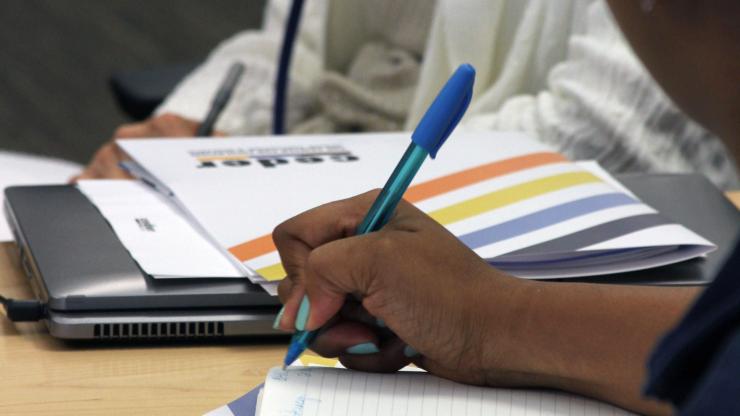CEDER’s Design Cycle
Digging into the “D” in CEDER
At CEDER, we describe our design work as “supporting the design and development of education curricula, programs, and tools for other units on campus and for K-12 and informal learning settings in surrounding communities.” But what does this actually mean, and what does this look like in practice? To answer these questions, I’ll outline our process and describe a few examples.
Each design project, although unique, follows some version of the process illustrated below.
The CEDER Design Cycle
Design work starts with an inquiry, which a past or potential new partner can initiate through email or our website form. I then follow up by meeting with them to discuss their needs and goals. If we move forward, we generate a shared vision for a product that includes format, audience, and purpose. Design projects generally fall into two broad categories: teacher professional learning experiences and curricular materials. Once we co-construct the shared vision, I develop a proposed scope of service, get feedback from the partner, and then formalize the agreement. Then the fun begins, and I design a prototype of the product. I get feedback on the prototype, and even pilot it when possible with an authentic audience. I then use the feedback to refine and improve the design. Then we move into implementation or dissemination, depending on whether it is a learning experience or instructional resource. The examples below illustrate how this process plays out in practice.
Opioid Facts Over Fear
In 2020 a team from the Injury Prevention Program at U-M’s C.S. Mott Children’s Hospital received funding to develop educational resources around opioid misuse prevention, and they reached out to CEDER for help in designing materials for middle school health classes. I met with their team over the course of a year to collaboratively develop what became an innovative, web-based curriculum. I had to do my own learning about pain, opioids, and the opioid crisis, and then work with the team to apply best-practices for web-based learning as we built the materials and activities. Engaging users and educators is core to our broader work and particularly important to our design work. As a designer, I needed to understand their needs, and then help them understand the needs and goals of middle school health educators. The CEDER evaluation team was engaged in this work as well. They ran focus groups with educators to get their input and feedback on the curriculum. An 8th grade science teacher shared,
""Meaningful curriculum is best developed when experts from inside the classroom can collaborate with community members of all sectors. It was such a pleasure being invited to share my thoughts on this innovative and important project, and the appreciation I received for my knowledge of best practices of 21st century learning was truly validating.”
This work culminated in the Opioid Facts Over Fear website, a free evidence-based resource for educators.
Islam Across the Globe
Another type of request I get from partners is to develop model lessons focused on specific content in order to provide teachers with ready-to-use resources that are aligned with a partner’s ongoing outreach efforts. I worked with the Center for Middle Eastern and North African Studies (CMENAS), for example, to develop lessons for high school global studies and world history around specific aspects of a workshop they were hosting on the topic of Islam Across the Globe.
I met the outreach team at CMENAS to understand their goals for the workshop, and then I researched Michigan content expectations and curricula for logical connection points. I then developed inquiry frames for three lessons that aligned with workshop goals, gathered source materials, and began to frame the actual lessons as document-based, inquiry learning experiences.
Everyone’s a Learner
In projects like these, although I’m working to produce something for a specific partner, I also try to anticipate the needs of the end-users of the work product: teachers and students. For teachers, I provide enough information and guidance so that the lesson is easy to access, adapt, and use. For students, I develop activities that are engaging and interesting and that will result in meaningful learning and connection to their lives. This work is always interesting as I get to partner with many different researchers and educators. I also get to be a learner in each project. I value the opportunity to develop quality resources and learning experiences for different audiences, and I always look back to my own time as both a student and a classroom teacher to keep my designs grounded and accessible. I’m proud to be a part of the CEDER team and look forward to continuing this work!
If you’d like to learn more about our work or partner with us on a design, evaluation, or research project, please start a conversation with us or reach out at [email protected].
Darin Stockdill, PhD is CEDER's Design Coordinator. When he’s not designing curricula or working with teachers, he likes to travel with his family, especially to places where he can be on a beach or hike up a mountain.
Design




